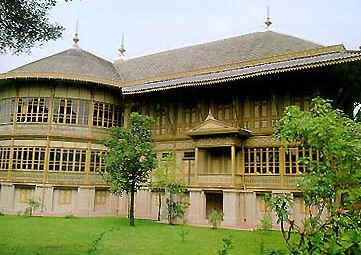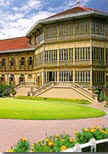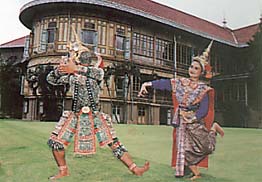

VimanMek Palace
 Vimanmek Palace
or Vimanmek Mansion Museum is located on Ratchawithi Road behind the National
Assembly. It is the world’s largest golden teak building. The 3-storey palace contains 81 rooms, halls and ante-chambers.
Vimanmek Palace
or Vimanmek Mansion Museum is located on Ratchawithi Road behind the National
Assembly. It is the world’s largest golden teak building. The 3-storey palace contains 81 rooms, halls and ante-chambers.
The building was originally constructed by King
Rama V (King Chulalongkorn, reigned 1868-1910) on Srichang Island in the
Gulf of Siam. Upon his return from Europe in1897, King Rama V (1868-1910) used his personal money to purchase orchards
and paddy fields between Padung Krungkasem Canal and Samsen Canal for the construction of a royal garden which he named
“the Dusit Garden”. The palace was built in
the shape of the Roman letter L with two wings, one running westward, the other
northward, joined at an angle of 90 degrees.
The first permanent residence in Dusit Garden was Vimanmek Mansion (Vimanmek
Palace), built in 1900 by the royal command of King Rama V. The mansion was in fact his former Summer Palace, the Munthaturaltanaroj Residence of the
Chuthathujrachathan at Koh Sri Chang, Chonburi, that was dismantled and rebuilt under the supervision of HRH Prince
Narissaranuwaddhiwongse. The celebration for the completion of Vimanmek Mansion was held on March 27, 1901. King Rama
V moved from the Grand Palace to reside in Vimanmek Mansion for 5 years until the completion of the Amporn Satarn Mansion
in 1906 where he lived until his untimely death in 1910.
After the death of King Rama V (Chulalongkorn) in
1910, Vimanmek Palace was infrequently used by King Rama VI (King
Vajiravudh). In 1925, near the end of his reign, King Rama VI gave permission to for H.R.H. Indharasaksaji, his wife, to take up
residence in a section of Vimanmek Mansion. After his death, she moved to the
residence in Suan Hong compound situated north of Vimanmek Mansion. The
palace was used for a short period by King Rama VII (King Prajadhipok)
during the early part of his reign when Amphorn Palace was being repaired. King Rama VII ordered a few renovations to the Mansion. For example, he ordered the installation of electrical wiring and
repairs to the main pier at the man-made lake in the garden. Since then, the
Vimanmek Mansion has not been used as a royal residence and has been used as a place of storage by the Bureau of the Royal
Household for the past 50 years.
In 1982, on the auspicious occasion of the Royal Bicentennial Celebrations of Bangkok, Her Majesty the Queen asked for
His Majesty’s permission to renovate the Mansion to be used as a museum to honour King Rama V by displaying his
photographs, art and artifacts to commemorate royal visits to Europe as well as to exhibit Thai handicrafts to serve as a
showcase of the national heritage for future generations.
The King's apartments on the palace's third floor have been decorated as they were during the reign of King Rama V (Chulalongkorn). The shower in the royal bathroom is believed to have been the first ever installed in Thailand. The tank was manually filled to provide sufficient water supply for the shower.
 Vimanmek Mansion is the largest residence in Dusit Garden. Its elaborate architectural style reflects a western influence. The
building has two right-angled wings. Each wing is 60 metres long and 20 metres high. It is a three-storey building except for
the part where the King resided, which is octagonal and has four storeys. The ground floor is brick and cement while the
upper floors are built of golden teakwood planks. There are altogether 31 exhibition rooms, some of which maintain the
atmosphere of the past, especially the bedrooms, the Audience Chamber and the bathrooms. Some rooms house exhibitions
of art works, for example, there is a silverware display room, a ceramic display room, a glassware display room and an ivory
display room.
Vimanmek Mansion is the largest residence in Dusit Garden. Its elaborate architectural style reflects a western influence. The
building has two right-angled wings. Each wing is 60 metres long and 20 metres high. It is a three-storey building except for
the part where the King resided, which is octagonal and has four storeys. The ground floor is brick and cement while the
upper floors are built of golden teakwood planks. There are altogether 31 exhibition rooms, some of which maintain the
atmosphere of the past, especially the bedrooms, the Audience Chamber and the bathrooms. Some rooms house exhibitions
of art works, for example, there is a silverware display room, a ceramic display room, a glassware display room and an ivory
display room.
Besides Vimanmek Mansion and the Amporn Satarn Mansion in the compound of Dusit Garden or Dusit Palace (as it was
later renamed by King Rama V), King Rama V allocated plots of land for the construction of residences for his Queens,
consorts, sisters, daughters, and his other wives. He also named gardens, canals, gates and roads after the names of ancient
Chinese porcelain commonly called “Khrueng Kim Tung”, which were very popular at the time. For example, the residence
that belonged to Her Majesty Queen Srisawarindhira was named Suan Hong Residence (Swan Garden Residence). Now
these residences, which are no longer used by the Royal Family and located north of Vimanmek Mansion, have been turned
into museum buildings and a hall for royal coaches to be shown to the general public.
Vimanmek Palace is surrounded by water on all sides: Klong Rong Mai Hom
(Fragrant Wood Canal) to the east, Klong Khab Phaen Krachok (Sheet of Glass
Canal) to the north, Klong Rang Ngoen (Silver Canal) to the west, and, best
known of all, the southern pond, Ang Yok (Jade Basin), named after the water's
natural greenness. A bridge crosses Ang Yok to wooden Thai houses called Ruan
Ton, built when Vimanmek Palace was erected. The King's express wish was to use
the houses for a non-royal style of living (that of a commoner), and it was
there he received the numerous acquaintances he made during frequent incognito
tours of Thailand.
Helpful Information
 A guided tour inside the building is provided to visitors.
Vimanmek Palace hours are from 9:30 A.M. to 3:15 P.M. everyday, including weekends and public holidays.
Each day there are two shows of traditional Thai dance at 10:30 A.M. and 2:00 P.M.
Admission fee for adults is 50 Baht and for student, monks, nuns is 20 Baht. Proper attire is
required - no shorts, sleeveless shirts or shower thongs.
A guided tour inside the building is provided to visitors.
Vimanmek Palace hours are from 9:30 A.M. to 3:15 P.M. everyday, including weekends and public holidays.
Each day there are two shows of traditional Thai dance at 10:30 A.M. and 2:00 P.M.
Admission fee for adults is 50 Baht and for student, monks, nuns is 20 Baht. Proper attire is
required - no shorts, sleeveless shirts or shower thongs.
Visitors will find ample services and facilities to make the Vimanmek Palace's trip a
pleasure,
such as currency exchange, Restaurants, and Thai Handy Craft Shops.
Location - Rajavithi Road, Dusit, Bangkok 10300
Phone : (662) 228-6300 - 9
Direct Information Services Call : (662) 280-5928
Copyright © 2000 - 2002 HelloSiam.com All rights reserved.